River Channel Relocation: Problems and Prospects
Abstract
:1. Introduction
2. Purposes of River Relocation
- Temporary river relocation for construction, such as temporary river relocation channels for dams [26], in which the river channel is temporarily diverted (Figure 2a), and the original channel is dried out to facilitate the construction of the dam or other structure across the river. Rivers can be temporarily diverted to clean up contaminants (e.g., relocation of the Coeur d'Alene River in Idaho for the clean-up of contaminated tailings (Figure 2b)).
- River relocation is carried out for flood control (e.g., Kaituna River, NZ [33]) to alter the location of the river channel to minimise damage from flooding.
3. River Relocation Classification
4. Case Studies of River Relocation
4.1. Lined Channel Relocation
4.2. Case Study: Morwell River Relocation, Victoria, AUS
4.3. Bedrock Relocation Tunnels
Bedrock Diversions for Coal Mining in the Bowen Basin, Queensland, Australia
4.4. Alluvial River Relocation Channels
4.4.1. Case Study: Twin Rivers Relocation, Heathrow Terminal 5, UK
4.4.2. Case Study: Kaituna River Relocation, New Zealand
5. Implications and Challenges of River Relocation
5.1. Fundamental Engineering Performance
River Relocation Channel Dimensions
5.2. Replicating Natural Channels
6. Improving River Relocation Designs
6.1. Case Study: Sugar Brook Relocation, Manchester Airport, UK
6.2 Improved Design Using Geomorphic Criteria: Example of the Bowen Basin Mining Relocations
ACARP Geomorphic Criteria
7. Long-Term River Relocation Rehabilitation
8. Future Research
9. Conclusions
Author Contributions
Acknowledgments
Conflicts of Interest
References
- Rosenberg, D.M.; McCully, P.; Pringle, C.M. Global-Scale Environmental Effects of Hydrological Alterations: Introduction. Bioscience 2000, 50, 746–751. [Google Scholar] [CrossRef]
- Tharme, R.E. A Global Perspective on Environmental Flow Assessment: Emerging trends in the development and application of environmental flow methodologies for rivers. River Res. Appl. 2003, 19, 397–441. [Google Scholar] [CrossRef]
- Halim, Y. The impact of human alterations of the hydrological cycle on ocean margins. Ocean Margin Process. Glob. Chang. 1991, 9, 301–327. [Google Scholar]
- Keller, E.A. Channelization: Environmental, geomorphic and engineering aspects. In Geomorphology and Engineering; Coates, D.R., Ed.; Dowden, Hutchinson and Ross Inc.: London, UK, 1976; pp. 115–140. [Google Scholar]
- Brookes, A. Downstream morphological consequences of river channelization in England and Wales. Geogr. J. 1985, 151, 57–62. [Google Scholar] [CrossRef]
- Brookes, A. Response of Aquatic Vegetation to Sedimentation Downstream from River Channelisation Works in England and Wales. Biol. Conserv. 1986, 38, 351–367. [Google Scholar] [CrossRef]
- Brandt, S.A. Classification of geomorphological effects downstream of dams. Cantena 2000, 40, 375–401. [Google Scholar] [CrossRef]
- Kingsford, R.T. Ecological impacts of dams, water diversions and river management on floodplain wetlands in Australia. Aust. Ecol. 2000, 25, 109–127. [Google Scholar] [CrossRef]
- Fantin-Cruz, I.; Pedrollo, O.; Girard, P.; Zeilhofer, P.; Hamilton, S.K. Changes in river water quality caused by a diversion hydropower dam bordering the Pantanal floodplain. Hydrobiologia 2016, 768, 223–238. [Google Scholar] [CrossRef]
- Poff, N.L.; Schmidt, J.C. How dams can go with the flow. Science 2016, 353, 1099–1100. [Google Scholar] [CrossRef] [PubMed]
- Petts, G.E. Time-scales for ecological change in regulated rivers. In Regulated Streams; Craig, J.F., Kemper, J.B., Eds.; Plenum: London, UK, 1987; pp. 257–266. ISBN 0306426749. [Google Scholar]
- Darby, S.; Sear, D. River Restoration: Managing the Uncertainty in Restoring Physical Habitat; John Wiley and Sons, Ltd.: Chichester, UK, 2008; pp. 1–315. [Google Scholar]
- Webber, M.; Crow-Miller, B.; Rogers, S. The South-North Water Transfer Project: Remaking the geography of China. Reg. Stud. 2017, 51, 370–382. [Google Scholar] [CrossRef]
- Hooke, J.M. Human impacts on fluvial systems in the Mediterranean region. Geomorphology 2006, 79, 311–335. [Google Scholar] [CrossRef]
- Chatelliers, M.C.D.; Reygrobellet, J.L. Interactions between geomorphological processes, benthic and hyporheic communities: First results on a by-passed canal of the french upper Rhône river. Regul. Rivers Res. Manag. 1990, 5, 139–158. [Google Scholar] [CrossRef]
- Department of Natural Resources and Mines. Guideline: Works that Interfere with Water in a Watercourse—Watercourse Diversions. September, 2014. State of Queensland. pp. 1–43. Available online: http://www.dnrm.qld.gov.au/__data/assets/pdf_file/0015/212424/guideline-watercourse-diversions.pdf (accessed on 28 September 2018).
- Erskine, W.D. Channel response to large-scale ricer training works: Hunter River, Australia. Regul. Rivers Res. Manag. 1992, 7, 261–278. [Google Scholar] [CrossRef]
- Soar, P.J.; Thorne, C.R. Channel Restoration Design for Meandering Rivers; U.S Army Corps of Engineers: Vicksburg, MS, USA, 2011; pp. 1–454.
- Yevjevich, V. Water diversions and Interbasin transfers. Water Int. 2001, 26, 342–348. [Google Scholar] [CrossRef]
- McEwan, A.L. The Failure of and Remedials to a River diversion for an opencast mine in the Witbank Coalfields of South Africa. Mine Water and Environment. In Proceedings of the 1999 IMWA Congress, Sevilla, Spain, 13–17 September 1999; pp. 79–85. [Google Scholar]
- Water Act. Available online: http://www.austlii.edu.au/cgibin/download.cgi/au/legis/cth/consol_act/wa200783 (accessed on 26 September 2018).
- Kemp, D.; Bond, C.J.; Franks, D.M.; Cote, C. Mining, water and human rights: Making the connection. J. Clean. Prod. 2010, 18, 1553–1562. [Google Scholar] [CrossRef]
- Minerals Council of Australia. Water Accounting Framework for the Minerals Industry, User Guide, Version 1.2. Available online: http://www. minerals. org. au/focus/sustainable_development/water_accounting (accessed on 26 September 2018).
- Mays, L.W. A very brief history of hydraulic technology during antiquity. Environ. Fluid Mech. 2008, 8, 471–484. [Google Scholar] [CrossRef]
- Cronin, L. A Journey through Ancient Kingdoms and Natural Wonders; World Heritage Sites of Australia, New Zealand and South East Asia; Reed Books: Sydney, Australia, 1995; p. 170. ISBN 9780730104889. [Google Scholar]
- Ratnayaka, D.D.; Brandt, M.J.; Johnson, K.M. Twort’s Water Supply, 6th ed.; Elsevier Ltd.: Oxford, UK, 2009; p. 744. ISBN 978-0-7506-6843-9. [Google Scholar]
- Petts, J. Handbook of Environmental Impact Assessment: Volume 2: Impact and Limitations; John Wiley and Sons, Ltd.: Chichester, UK, 2009; pp. 1–464. ISBN 9781444311495. [Google Scholar]
- Seddon, C. Diversion of a River Valley. Manual of River Restoration Techniques. 2013, pp. 1–5. Available online: http://www.therrc.co.uk/MOT/Final_Versions_%28Secure%29/11.1_Sugar_Brook.pdf (accessed on 26 September 2018).
- Holmes, P.J.; Meadows, M. Southern African Geomorphology: Recent Trends and New Directions; Sun Media Bloemfontein: Bloemfontein, South Africa, 2012; p. 431. ISBN 978-1-920382-02-5. [Google Scholar]
- Atkinson, S.; Markham, A.; Rafty, M.; Heyting, M. Pilbara Creek Diversions: Resilience gained through increased ore recovery and an integrated approach to design. In Proceedings of the AUSIMM Iron Ore Conference, Perth, Australia, 24–26 July 2017; pp. 1–20. [Google Scholar]
- Hinton, J.J.; Veiga, M.M.; Veiga, A.T.C. Clean artisanal gold mining: A utopian approach. J. Clean. Prod. 2003, 11, 99–115. [Google Scholar] [CrossRef]
- Byizigiro, R.V.; Raab, T.; Maurer, T. Small-scale open cast mining: An important research field for anthropogenic geomorphology. Die Erde—J. Geogr. Soc. Berl. 2015, 146, 213–231. [Google Scholar] [CrossRef]
- Mawer, J.C. Morphology of the Te Tumu Cut Under the Potential Re-Diversion of the Kaituna River. Ph.D. Thesis, University of Waikato, Hamilton, New Zealand, 2012; pp. 1–158. [Google Scholar]
- Ward, G.H.; Irlbeck, M.J.; Montagna, P.A. Experimental River Diversion for Marsh Enhancement. Estuaries 2002, 25, 1416–1425. [Google Scholar] [CrossRef]
- Wang, H.; Steyer, G.D.; Couvillion, B.R.; Beck, H.J.; Rybczyk, J.M.; Rivera-Monroy, V.H.; Krauss, K.W.; Visser, J.M. Predicting landscape effects of Mississippi River diversions on soil organic carbon sequestration. Ecosphere 2017, 8, 1–15. [Google Scholar] [CrossRef]
- Fisher, K.; Ramsbottom, D. River Diversions: A Design Guide; Thomas Telford Publishing: London, UK, 2001; p. 176. ISBN 9780727729590. [Google Scholar]
- Eakin, H.M. The Porcupine Gold Placer District, Alaska; U.S Geological Survey Bulletin: Washington, DC, USA, 1919; pp. 1–29.
- National Research Council of the National Academies. The Coeur d’ Alene System. In Superfund and Mining Megasites: Lessons from the Coeur d’ Alene River Basin; National Academies Press: Washington, DC, USA, 2005; pp. 47–484. [Google Scholar]
- Rocca, A. Shasta Lake: Boomtowns and the Building of the Shasta Dam; Arcadia Publishing: Dover, NH, USA, 2002; p. 64. ISBN 0-7385-2076-4. [Google Scholar]
- Gilvear, D.; Perfect, C. Clay Lined River. Manual of River Restoration Techniques. 2013, pp. 1–7. Available online: http://www.therrc.co.uk/sites/default/files/projects/p449.pdf (accessed on 27 September 2018).
- The River Restoration Center. River Restoration News. 2000. Available online: http://www.therrc.co.uk/site/default/files/newsletters/issue5.pdf (accessed on 28 September 2018).
- Risbridger, T. Terminal 5 Twin Rivers Diversion- Critical Sub-Project in Airport’s T5 expansion Programme. Water Treat Supply. 2007. Available online: http://www.waterprojectsonline.com/case_studies/2007/EAHeathrow T5 River Diversion 2007.pdf (accessed on 28 September 2018).
- Pennington, M.; Spence, J. Piled foundations for the M25 motorway near Heathrow Airport. In Advances in Transportation Geotechnics; Ed, E., Yu, H.S., Glenn, M.D., Andrew, D., Nick, T., Eds.; CRC Press: Nottingham, UK, 2008; pp. 453–457. ISBN 978-0-415-47590-7. [Google Scholar]
- Schultze, M.; Pokrandt, K.H.; Hille, W. Pit lakes of the Central German lignite mining district: Creation, morphometry and water quality aspects. Limnol.—Ecol. Manag. Inland Waters 2010, 40, 148–155. [Google Scholar] [CrossRef]
- Vandvik, V.; Måren, I.E.; Ndangalasi, H.J.; Taplin, J.; Mbago, F.; Lovett, J.C. Back to Africa: Monitoring post-hydropower restoration to facilitate reintroduction of an extinct-in-the-wild-amphibian. Ecosphere 2014, 5, 1–17. [Google Scholar] [CrossRef]
- Harvey, M.; Pearcey, M.; Price, K.; Devkota, B. Geomorphic, hydraulic and sediment transport modelling for mine related channel realignment—Case Study: Caves Creek, Pilbara, Western Australia. In Hydrology and Water Resources Symposium 2014; Engineers Australia: Queensland, Australia, 2014; pp. 259–266. [Google Scholar]
- McArthur River Mining. Memorandum. September 2007, Edition 6. 2007, pp. 1–8. Available online: http://www.mcarthurrivermine.com.au/en/publications/MemorandumMagazine/MemoranduM_issue6(1).pdf (accessed on 27 September 2018).
- Hallgath, A.; Pearson, B.A. Watercourse diversions relinquishment in Queensland—A risk-based approach to monitoring. In Mine Closure 2016; Fourie, A.B., Tibbett, M., Eds.; Australian Center for Geomechanics: Perth, Australia, 2016; pp. 447–460. [Google Scholar]
- Ulan Coal Glencore. Goulburn River Diversion Erosion and Sediment Control Plan. ULN SD PLN 0130. 2017, pp. 1–38. Available online: http://www.ulancoal.com.au/en/environment/EnvironmentManagementPlan/Goulburn%20River%20Diversion%20Erosion%20Sediment%20Control%20Plan.pdf (accessed on 28 September 2018).
- Spark, H.; Temple, L. Morwell River Diversion. ACAA.06. Ashton Coal. Appendix 1. Bowmans Creek Diversion Response to Submissions. 2010, pp. 1–7. Available online: http://www.ashtoncoal.com.au/icms_docs/254841_response-to-submissions-part-1.pdf (accessed on 28 September 2018).
- Victorian Heritage Database. Thomson River Diversion Tunnel Site. 2018; pp. 1–8. Available online: http://vhd.heritagecouncil.vic.gov.au/places/10756 (accessed on 27 September 2018).
- Monchy, P. Kaituna River Re-diversion and wetland creation project. In Assessment of Environmental Effects-Summary; Bay of Plenty Regional Council: Whakatane, New Zealand, 2014; pp. 1–11. [Google Scholar]
- Lawrence, S.; Davies, P. Learning about landscape: Archaeology of water management in colonial Victoria. Aust. Archeol. 2012, 74, 47–54. [Google Scholar] [CrossRef]
- Cosgrove, D. An elemental division: Water control and engineered landscape. In Water, Engineering and Landscape; Cosgrove, D., Petts, G., Eds.; Belhaven Press: London, UK, 1990; pp. 1–11. [Google Scholar]
- Mason, L.; Unger, C.; Lederwasch, A.; Razian, H.; Wynne, L.; Giurco, D. Adapting to Climate Risks and Extreme Weather: A Guide for Mining and Mineral Industry Professionals; National Climate Change Adaptation Research Facility: Gold Coast, Australia, 2013; p. 76. ISBN 978-1-925039-24-5. [Google Scholar]
- Laurence, D.; Stamford, C.; Barry, S.; Oosting, N.; Andryszczk, H.; Fawsett, M.; Jones, D. A Guide to Leading Practice Sustainable Development in Mining; Australian Government Department of Resources and Tourism: Canberra, Australia, 2011; pp. 1–204. ISBN 978-1-92-1812-49-1.
- Hardie, R.; Nat, M.; Hall, D.; Tilleard, J. Design of a river for a modified environment. In Hydro 2000: Interactive Hydrology; Institute of Engineers: Barton, ACT, Australia, 2000; pp. 1024–1029. ISBN 0957824114. [Google Scholar]
- Treadwell, S.; Dettrick, D. Morwell River Diversion Collapse Environmental Risk Assessment; Sinclair Knight Merz: Sydney, Australia, 2012; pp. 1–105. [Google Scholar]
- EPA Victoria. Yallourn Mine—Community Information. Publication 1494; August 2012. Available online: http://www.epa.vic.gov.au/~/media/Publications/1494.pdf (accessed on 27 September 2018).
- Song, M. $109m bill for Yallourn. In Latrobe Valley Express; Latrobe Valley Express Partnership: Morwell, Australia, 2012. [Google Scholar]
- CLP Holdings. Media Release: CLP Holdings Limited announces 2013 Annual Results. 27 February 2014, pp. 1–2. Available online: https://www.clpgroup.com/en/Media-Resources-site/Current%20Releases/20140227_Eng.pdf (accessed on 27 September 2018).
- Victorian Heritage Register. Thomson River Diversion Tunnel Site. 2017. Available online: http://vhd.heritagecouncil.vic.gov.au/places/10756 (accessed on 27 September 2018).
- Hartman, H.L.; Mutmansky, J.M. Introductory Mining Engineering, 2nd ed.; John Wiley and Sons: Hoboken, NJ, USA, 2002; pp. 1–570. ISBN 0-471-34851-1. [Google Scholar]
- Welsh, L.; Travers, I. Thomson River Fishway. In Heritage Impact Statement; Extent Heritage Pty. Ltd.: Sydney, Australia, 2017; pp. 1–24. [Google Scholar]
- Ulan Coal Glencore. Goulburn River Diversion Remediation Plan. ULN SD PLN 0054. 2016, pp. 1–120. Available online: http://www.ulancoal.com.au/en/environment/EnvironmentManagementPlan/Goulburn%20River%20Diversion%20Remediation%20Plan.pdf (accessed on 28 September 2018).
- URS. Goulburn River Diversion—Long Term Stability Strategy; Ulan Coal Mines Limited.: Sydney, Australia, 2009. [Google Scholar]
- Eco Logical Australia Pty Limited. Goulburn River Diversion Rehabilitation Works—Vegetation Assessment and Revegetation Recommendations; Ulan Coal Mines Limited.: Sydney, Australia, 2014. [Google Scholar]
- Ulan Coal Glencore. Plan for Goulburn River Diversion Erosion and Sediment Control Plan. ULN SD PLN 0130; Environment and Community Manager, 2017; pp. 1–38. Available online: http://www.ulancoal.com.au/en/environment/EnvironmentManagementPlan/Erosion-and-Sediment-Control-Plan.pdf (accessed on 28 September 2018).
- White, K.; Hardie, R. Maintenance of Geomorphic Processes in Bowen Basin River Diversions. ACARP Project C8030. 2000. Available online: https://trove.nla.gov.au/version/43316977 (accessed on 28 September 2018).
- White, K.; Lucas, R.; Hardie, R.; Moar, D.; Blackham, D. Criteria for Functioning River Landscape Units in the Mining and Post Mining Landscapes. Report prepared for ACARP Project C20017. 2014. Available online: https://www.acarp.com.au/abstracts.aspx?repId=C20017 (accessed on 28 September 2018).
- Department of Natural Resources and Mines. Guideline: Works that Interfere with Water in a Watercourse: Watercourse Diversions; State of Queensland: Queensland, Australia, 2014; pp. 1–43.
- White, K.; Hardie, R.; Lucas, R.; Merritt, J.; Kirsch, B. The evolution of watercourse diversion design in central Queensland coal mines. In Proceedings of the 7th Australian Stream Management Conference, At Townsville, Australia, 27–30 July 2014; Vietz, G., Rutherfurd, I.D., Hughes, R., Eds.; University of Melbourne: Victoria, Australia, 2014; pp. 338–348, ISBN 978 0 7340 5038 0. [Google Scholar]
- CEEQUAL. The Twin Rivers Diversion Scheme. 1 January 2005. Available online: http://www.ceequal.com/case-studies/the-twin-rivers-diversion-scheme/ (accessed on 27 September 2018).
- Palmer, D.; Wilbraham, P. Heathrow Terminal 5: Twin rivers diversion. Civ. Eng. 2008, 161, 25–29. [Google Scholar] [CrossRef]
- Purohit, A.A.; Vaidya, M.M.; Kudale, M.D. Application of unstructured mesh modelling in evolving SGE of an airport at the confluence of multiple rivers in a macro tidal region. World Acad. Sci. Eng. Technol. Int. J. Environ. Chem. Ecol. Geol. Geophys. Eng. 2017, 11, 241–255. [Google Scholar]
- Clark, P.B.; Palmer, D.K.; Joyce, P.; Pether, R.V. Environmental aspects of the hydraulic design for the twin rivers diversion for Terminal 5, Heathrow Airport. In Environmental Hydraulics and Sustainable Water Management; Lee, J.H.W., Lam, K.M., Eds.; Taylor & Francis: Abingdon, UK, 2004; pp. 847–852. ISBN 0415365465. [Google Scholar]
- AMEC. Heathrow’s North-West Runway, Assessment of Flood Risk. AMEC Environment and Infrastructure; Heathrow Airport Limited.: Heathrow, UK, 2014; pp. 1–52. [Google Scholar]
- Lister, B. Heathrow Terminal 5: Enhancing environmental sustainability. Civ. Eng. 2008, 161, 21–24. [Google Scholar] [CrossRef]
- Goodhue, N.D. Hydrodynamic and Water Quality Modelling of the Lower Kaituna River and Maketu Estuary. Ph.D. Thesis, University of Waikato, Hamilton, New Zealand, 2007; pp. 1–165. [Google Scholar]
- Tortell, P. Public Involvement in the Search for a Solution to the Problems of the Maketu Estuary. In Proceedings of the 1985 Australasian Conference on Coastal and Ocean Engineering, Institute of Civil Engineers, Adelaide, Australia, 4–8 December 1985; pp. 256–269. [Google Scholar]
- Wallace, P. Fords Cut. History and Bank Erosion Assessment. Report prepared for Environment Bay of Plenty. 2008; pp. 1–23. Available online: https://www.boprc.govt.nz/media/32659/pwallace-090803-fordscuthistory.pdf (accessed on 27 September 2018).
- Boothway, D. Room for the River—A New Zealand Perspective. In Hydrology and Water Resources Symposium 2014; Engineers Australia: Queensland, Australia, 2014; pp. 670–677. ISBN 9781922107190. [Google Scholar]
- Tuckey, B. Kaituna River to Maketu Estuary Re-Diversion: Model Calibration and Initial Hydrodynamic Impact Assessment; DHI Water and Environment Limited.: Auckland, New Zealand, 2009; pp. 1–63. [Google Scholar]
- Domijan, N. The hydrodynamic and estuarine physics of Maketu Estuary. Ph.D. Thesis, University of Waikato, Hamilton, New Zealand, 2000. [Google Scholar]
- Everitt, S.; Monchy, P. Kaituna River Re-Diversion and Wetland Creation Project: Scoping Report for Assessment of Environmental Effects; Bay of Plenty Regional Council Environmental Publication: Whakatāne, New Zealand, 2013; pp. 1–29. [Google Scholar]
- Hardie, R.; Lucas, R. Bowen Basin River Diversions Design and Rehabilitation Criteria. Report prepared for ACARP Project C9068, Fisher Stewart, 2002. Available online: https://www.acarp.com.au/abstracts.aspx?repId=C8030_C9068 (accessed on 28 September 2018).
- Canadian Environmental Assessment Agency. Rainy River Project Environmental Assessment Report; Canadian Environmental Assessment Agency: Ottawa, ON, Canada, 2015; pp. 1–231. ISBN 978-1-100-25429-6.
- Schoenheinz, D.; Grünewald, U.; Koch, H. Aspects of Integrated Water Resources Management in River Basins Influenced by Mining Activities in Lower Lusatia. Global Change: Challenges for regional Water Resources. Die Erde—J. Geogr. Soc. Berl. 2011, 142, 163–186. [Google Scholar]
- CH2M Hill. A second Runway for Gatwick Appendix A12. In Water Flood Risk; 2014; pp. 1–234. Available online: https://assets.publishing.service.gov.uk/government/uploads/system/uploads/attachment_data/file/368993/20_Appendix_A12_Water_Flood_Risk.pdf (accessed on 28 September 2018).
- Cordeiro, N.J.; Lovett, J.C.; Mulungu, E.; Maina, G.G.; Gerstle, J.H. Initial trends of bird assemblages before and after river diversion in an endemic-rich African forest. Biodivers. Conserv. 2006, 15, 971–983. [Google Scholar] [CrossRef]
- Australian Government. A Guide to Leading Practice Sustainable Development Program for the Mining Industry; Department of Resources Energy and Tourism: Canberra, Australian, 2008; pp. 1–112. ISBN 6642726051.
- Palmer, M.A.; Menninger, H.L.; Bernhardt, E. River restoration, habitat heterogeneity and biodiversity: A failure of theory or practice. Freshw. Biol. 2009, 55, 1–18. [Google Scholar] [CrossRef]
- Naylor, A.E. Improvement of the runway at Manchester Airport. Proc. Inst. Civ. Eng. 1984, 76, 221–236. [Google Scholar] [CrossRef]
- Bebbington, A.; Williams, M. Water and Mining conflicts in Peru. Mt. Res. Dev. 2008, 28, 190–195. [Google Scholar] [CrossRef]
- Erskine, W.D. Review of the McArthur River Mine Open Cut Project Public Environmental Report; The University of Newcastle: Newcastle, Australia, 2009; pp. 1–19. Available online: https://ntepa.nt.gov.au/__data/assets/pdf_file/0003/288084/rpt54_app3.pdf (accessed on 26 September 2018).
- Lucas, R.; Crerar, J.; Hardie, R.; Merritt, J.; Kirsch, B. Isaac river cumulative impact assessment of mining developments. Min. Technol. 2009, 118, 142–151. [Google Scholar] [CrossRef]
- Brierley, G.; Fryirs, K.; Outhet, D.; Massey, C. Application of the River Styles framework as a basis for river management in New South Wales, Australia. Appl. Geogr. 2002, 22, 91–122. [Google Scholar] [CrossRef]
- Hallgath, A.; Pearson, B. Watercourse diversions relinquishment in Queensland—A risk based approach to monitoring. In Proceedings of the 11th International Conference on Mine Closure; Australian Centre for Geomechanics: Perth, Australian, 2016; pp. 447–460. [Google Scholar]
- Nawrot, J.; O’Leary, W.G.; Malone, P. Stream restoration: Past practices—Current benchmarks. In Proceedings of the America Society of Mining and Reclamation, Pittsburgh, PA, USA, 4–10 June 2010; pp. 652–671. [Google Scholar]
- US Department of the Interior. Proposed mining and reclamation plan. In Environmental Impact Statement OSM-EIS-9; North Rochelle Mine: Campbell County, WY, USA, 1982; pp. 1–154. [Google Scholar]
- McCullough, C.; Schultz, M. Riverine Flow-Through of Mine Pit Lakes: Improving both Mine Pit Lake and River Water Quality Values? In Proceedings of the 10th International Conference on Acid Rock Drainage and IMWA Annual Conference, Santiago, Chile, 21–24 April 2015; pp. 1–10. [Google Scholar]
- Grace, D.; McLeary, M.; Davies, G. Drainage principles and design for mine closure in the Pilbara. In Hydrology and Water Resources Symposium 2014; Engineers Australia: Queensland, Australia, 2014; pp. 94–100. [Google Scholar]
- Heikkinen, P.; Noras, P.; Salminen, R. Environmental Techniques for the Extractive Industries. In Mine Closure Handbook; Outokumpu: Helsinki, Finland, 2008; ISBN 978.952-217-055-2. [Google Scholar]
- Blanchette, M.L.; Lund, M.A.; Stoney, R.; Short, D.; Harkin, C. Bio-physical closure criteria without reference sites: Realistic targets in modified rivers. In IMWA 2016—Mining Meets Water—Conflicts and Solutions; Wolkersdorfer, C., Sartz, L., Sillanpää, M., Häkkinen, A., Eds.; Technische Universität Bergakademie: Freeiberg, Germany, 2016; pp. 586–592. [Google Scholar]
- McMahon, T.A.; Finlayson, B.L. Droughts and anti-droughts: The low flow hydrology of Australian rivers. Freshw. Biol. 2003, 48, 1147–1160. [Google Scholar] [CrossRef]
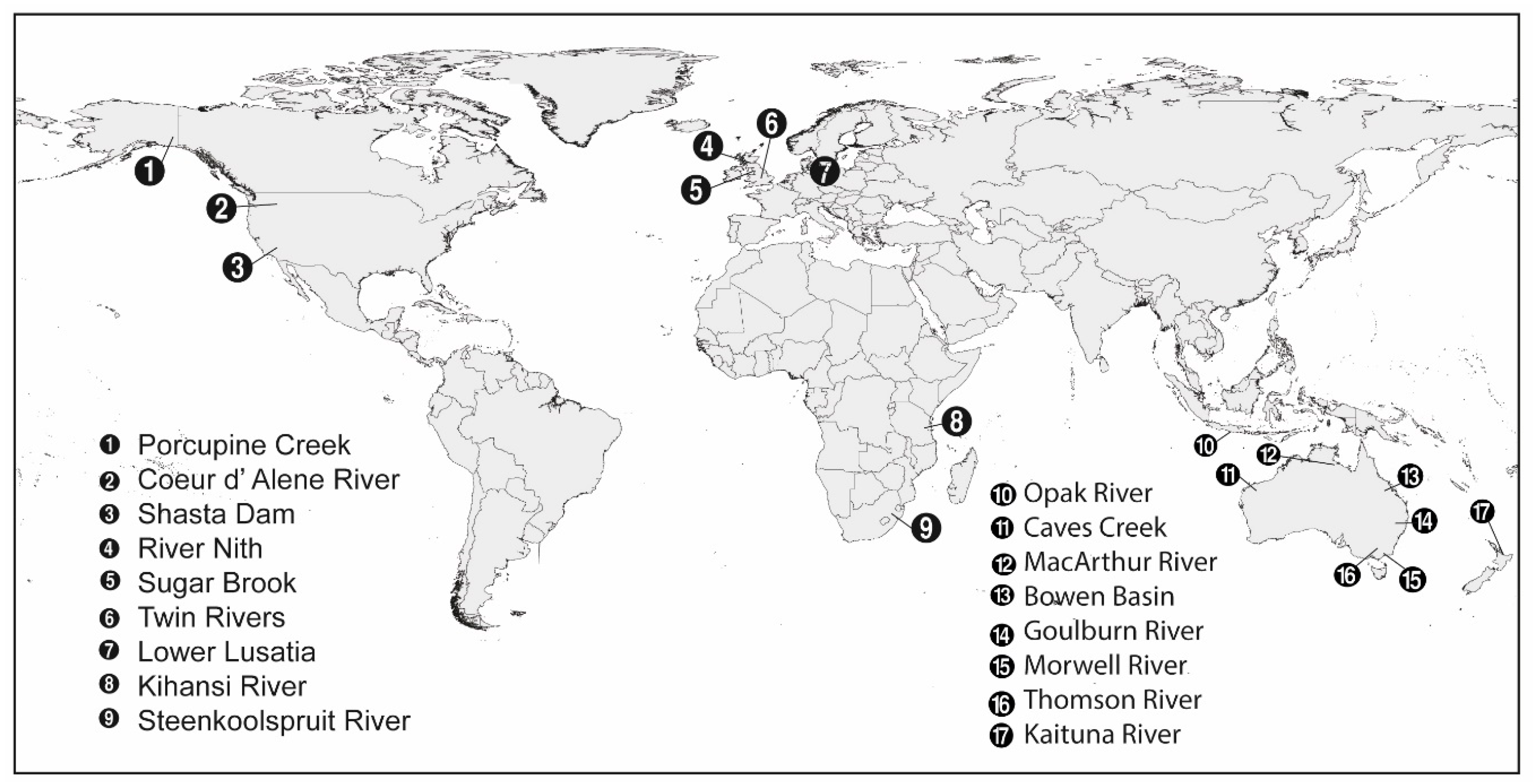


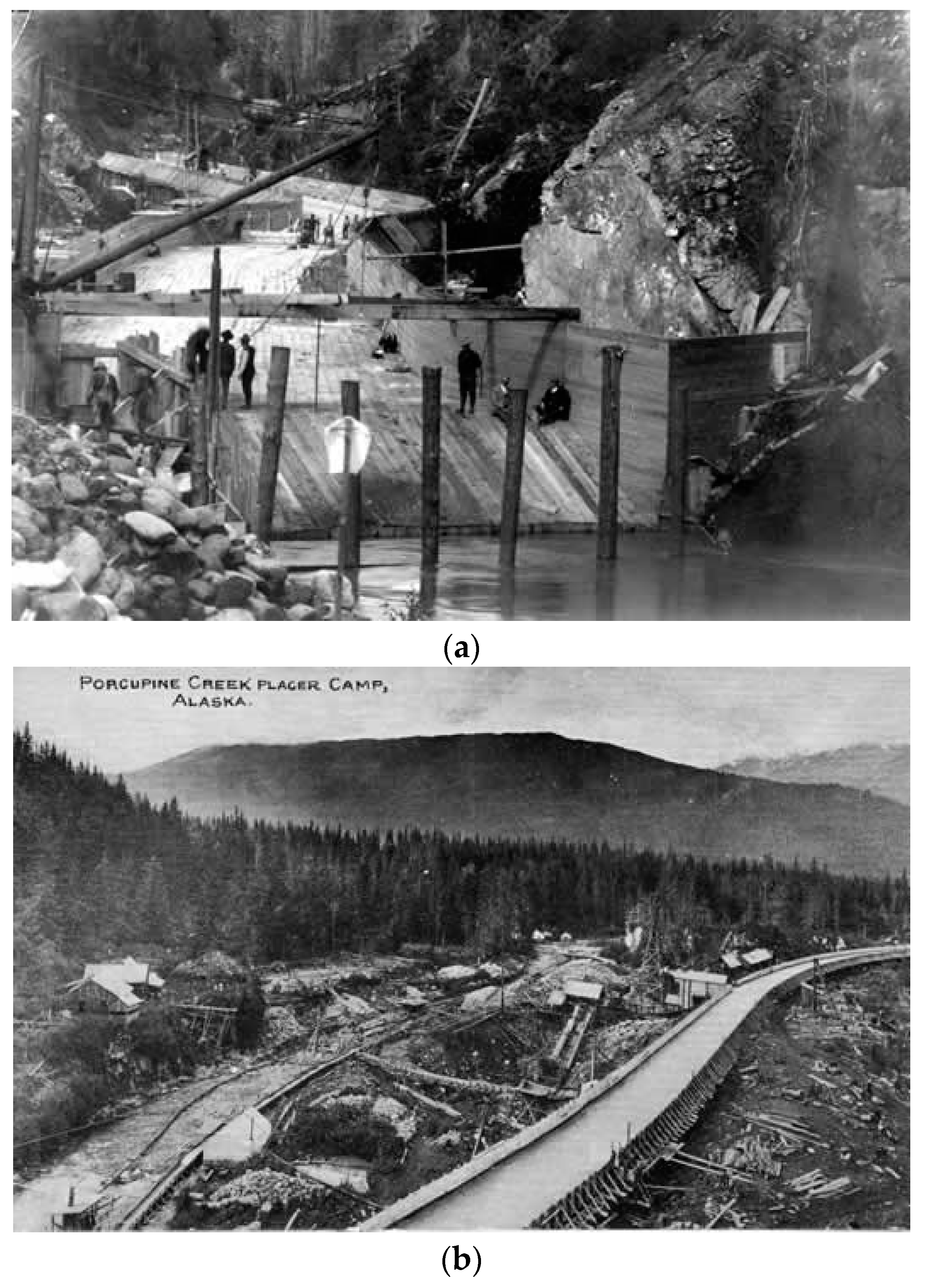
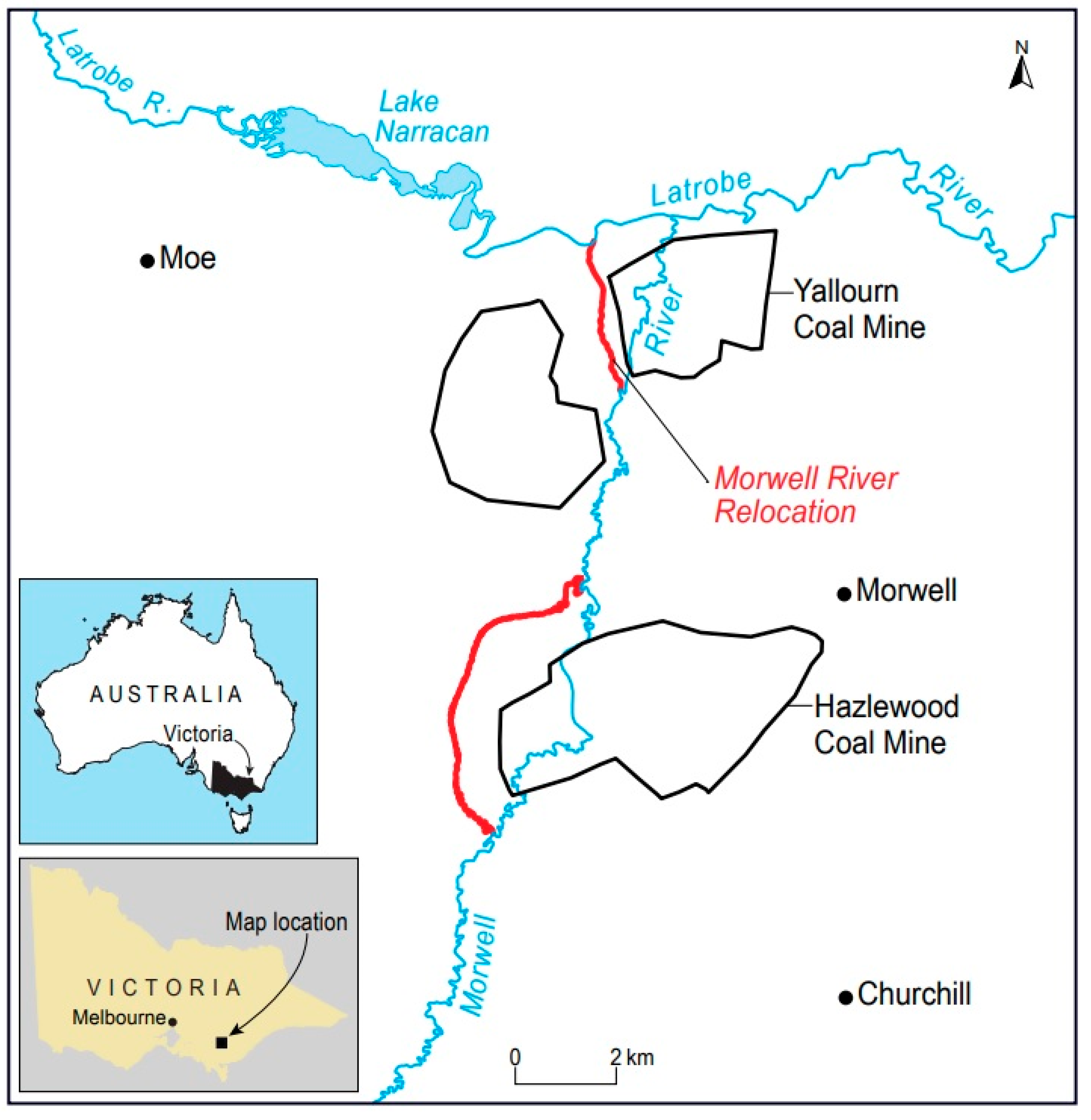

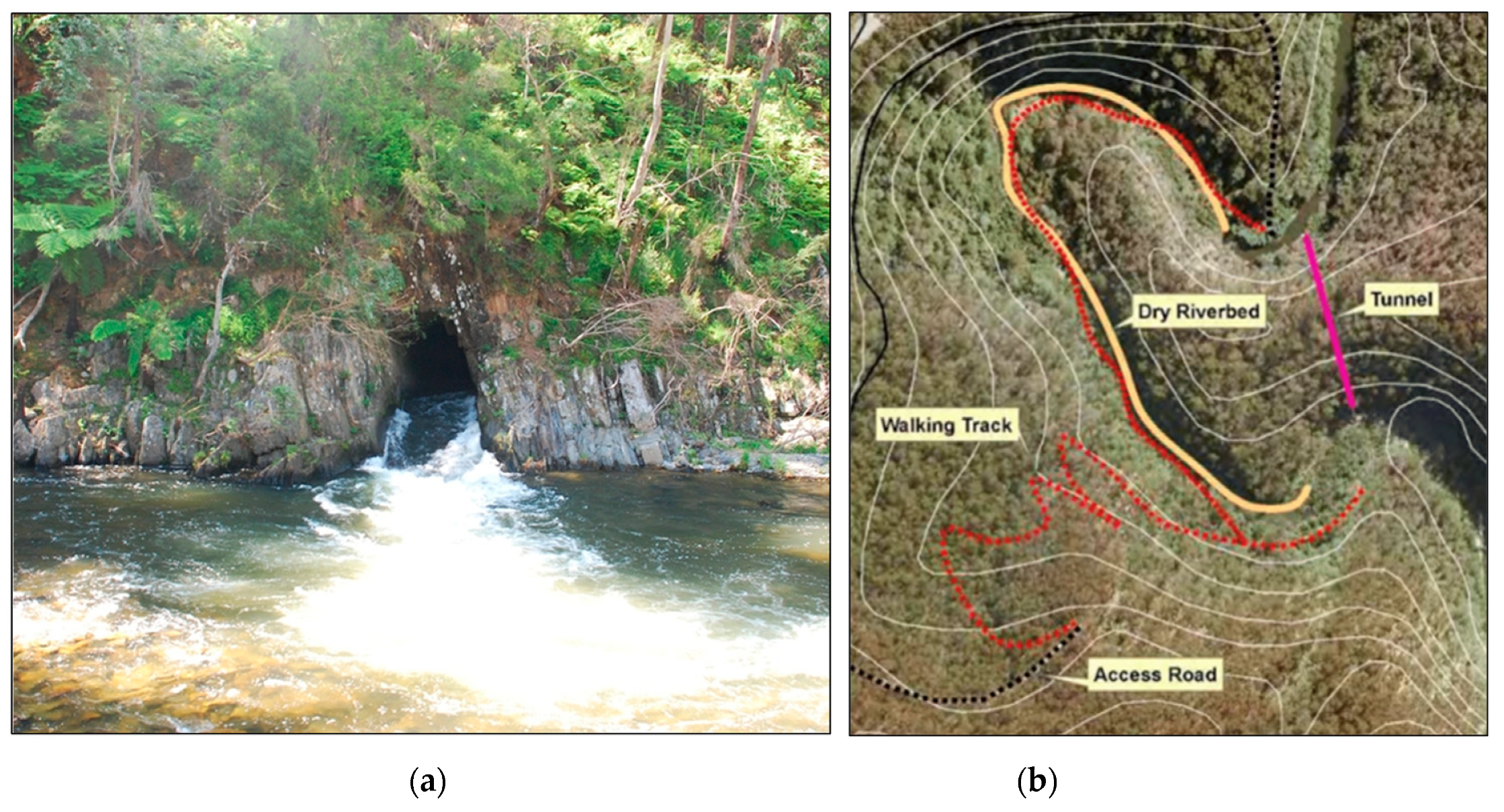
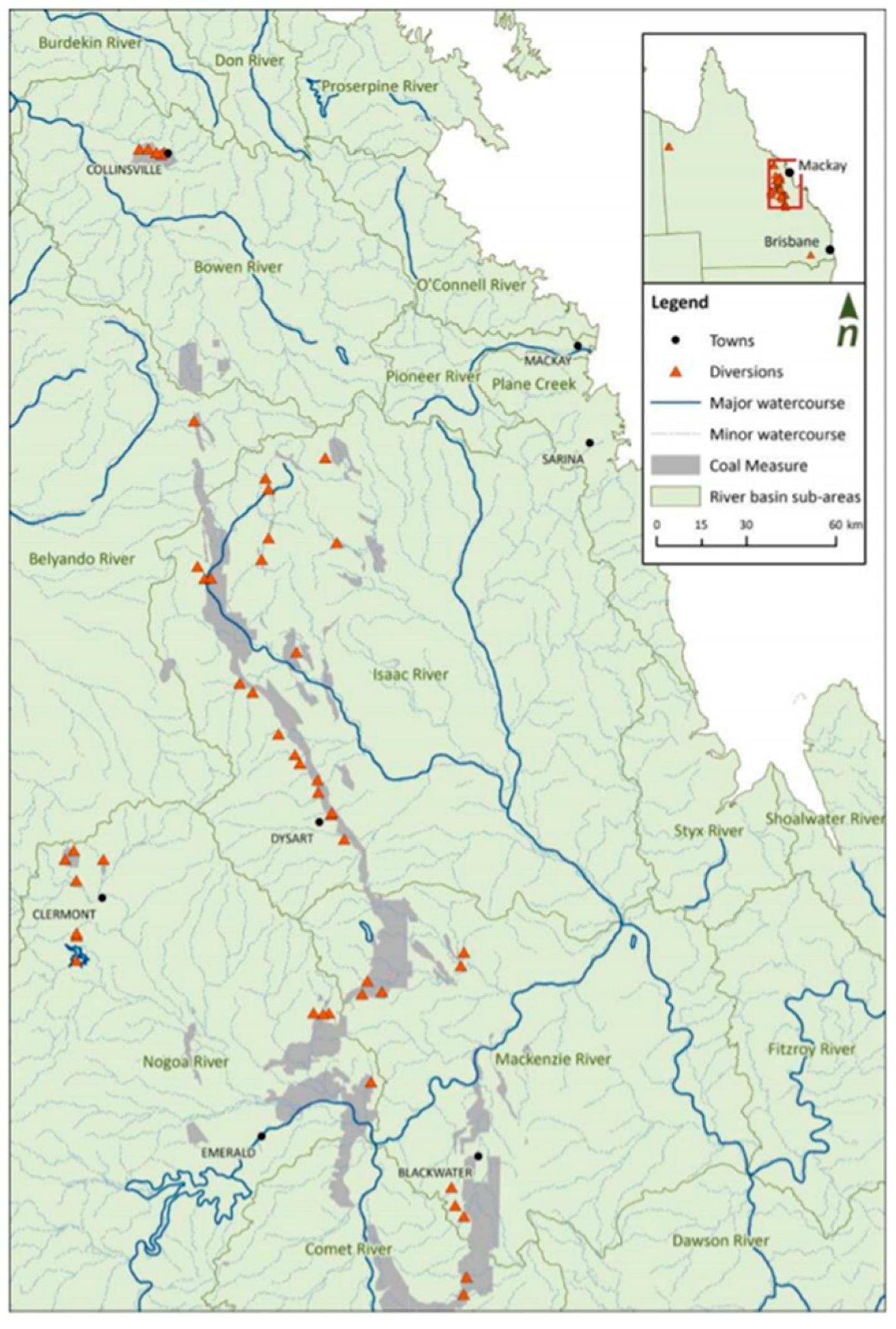
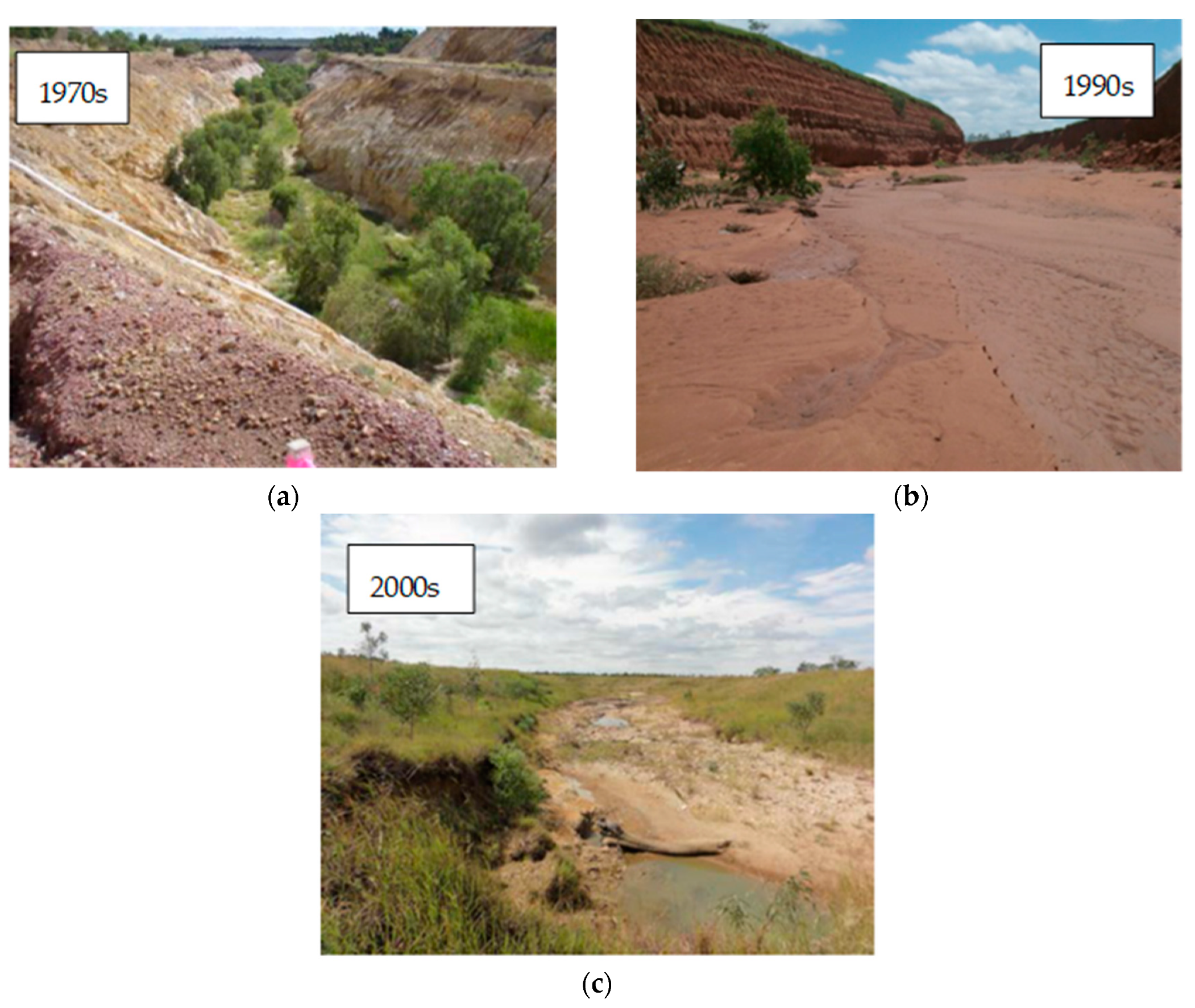

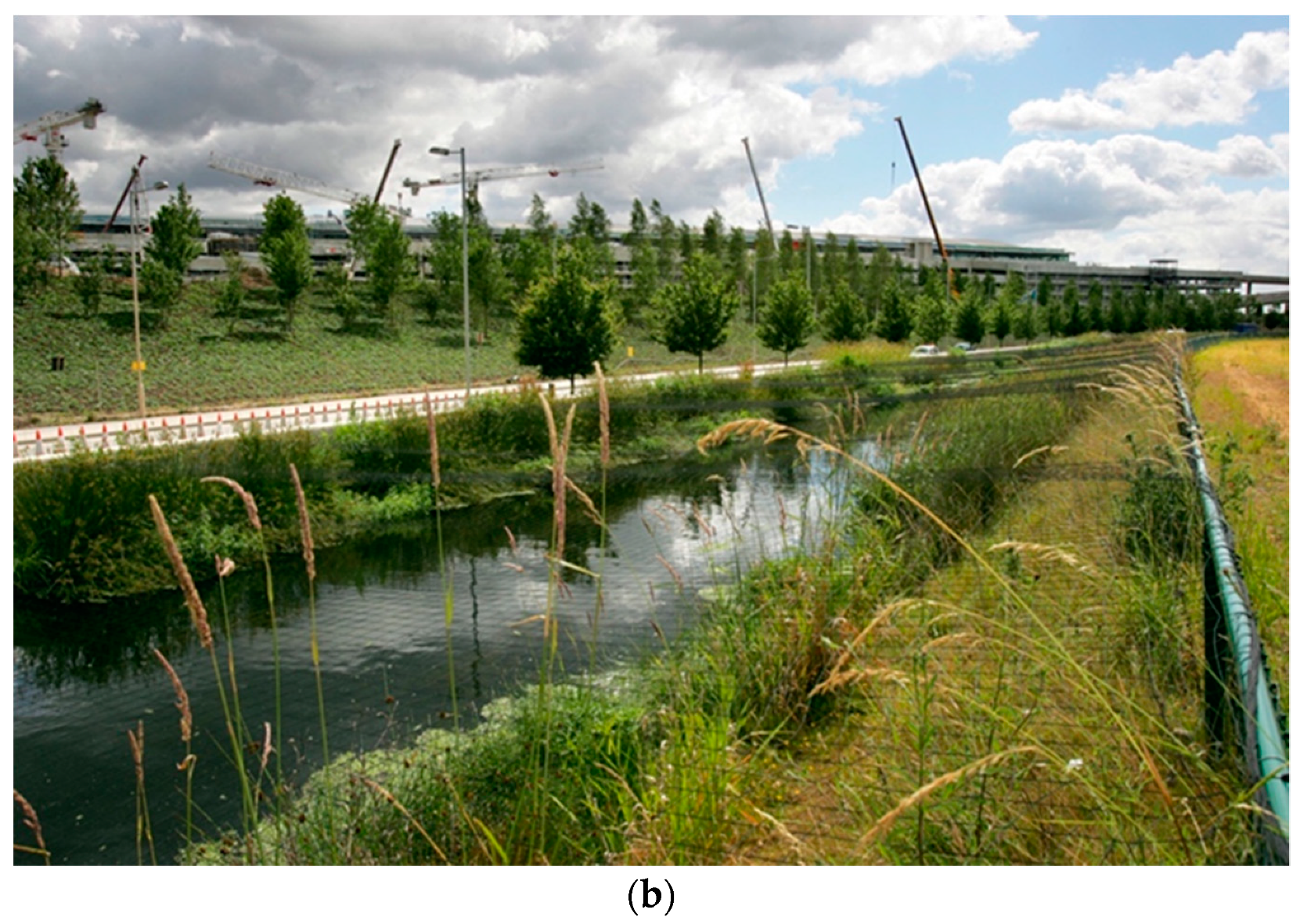
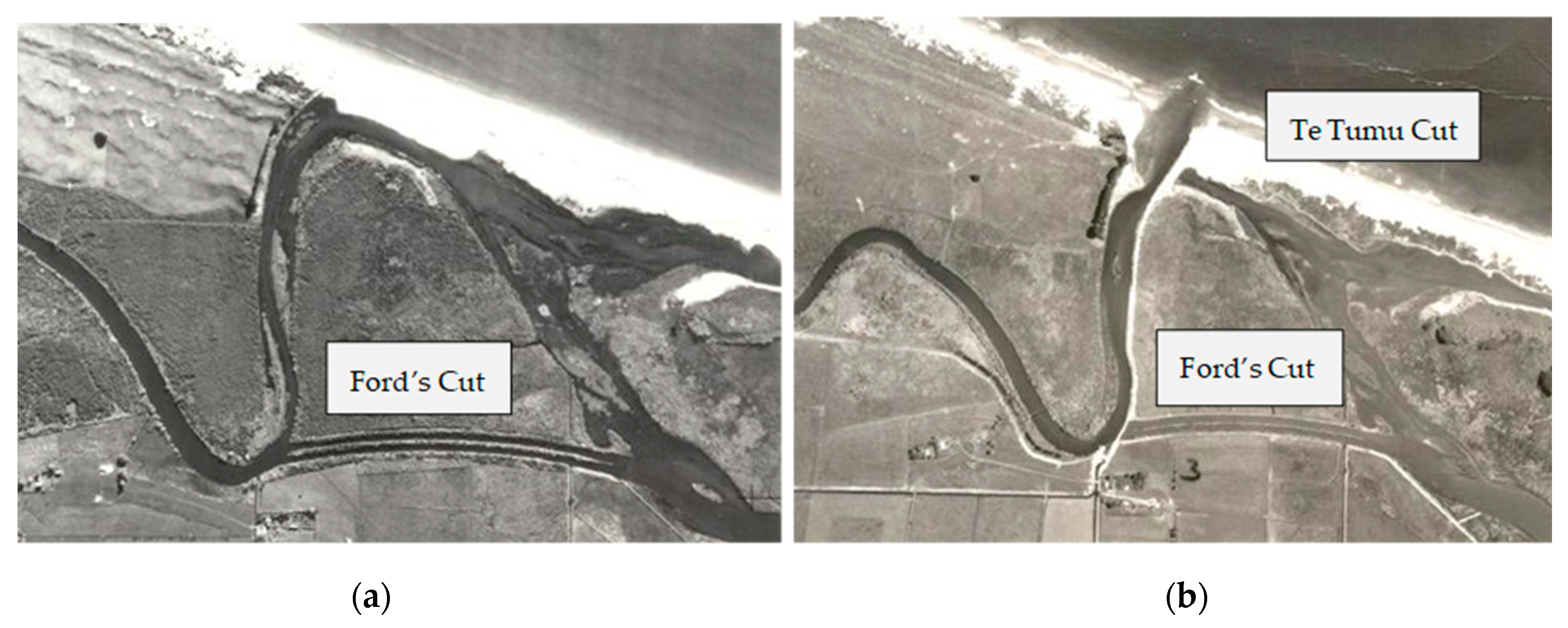


| River Relocation | Purpose | Classification | Year Constructed |
|---|---|---|---|
| Porcupine Creek, Alaska, USA | Alluvial mining | Temporary, Lined Channel | 1907–1918 [37] |
| Coeur d’ Alene, Idaho, USA | River restoration | Temporary, Lined Channel | 2005 to present [38] |
| Shasta Dam, California | Dam construction | Temporary, Bedrock | 1938–1940 [39] |
| River Nith, Scotland | Coal mining | Permanent, Alluvial | 2000–2004 [40] |
| Sugar Brook, England | Airport construction | Permanent Alluvial | 1998–1999 [41] |
| Twin Rivers, England | Airport construction | Permanent, Lined | 2002–2004 [42] |
| Wraysbury River, England | Motorway construction | Permanent, Lined | 1986 [43] |
| Lower Lusatia, Germany | Coal mining | Permanent, Lined | 1975–1976 [44] |
| Kihansi River, Tanzania | Dam construction | Permanent, Lined | 1999 [45] |
| Steenkoolspruit River, South Africa | Coal mining | Permanent, Lined | 1992 [20] |
| Opak River, Indonesia | Temple construction | Permanent, Lined | Ninth century [25] |
| Caves Creek, WA, Australia | Iron ore (open-pit) mining | Permanent, Alluvial | 2014 [46] |
| MacArthur River, Australia | Lead and zinc mining | Permanent, Alluvial | 2008 [47] |
| Bowen Basin, Australia | Coal mining | Permanent, Alluvial/Bedrock | 1970–2012 [48] |
| Goulburn River, Australia | Coal mining | Permanent, Bedrock | 1981 [49] |
| Morwell River, Australia | Coal mining | Permanent, Lined | Multiple modifications made from 1977–2012 [50] |
| Thomson River, Australia | Alluvial mining | Permanent, Bedrock | 1911–1912 [51] |
| Kaituna River, New Zealand | Flood prevention | Permanent, Alluvial | Modifications made in 1926, 1956, and 1995 [52] |
| Key Issue | Type | Example |
|---|---|---|
| Primary | ||
| Change in channel dimensions based on new channel design. | Physical | Morwell River, AU [57] |
| Changes in flow velocity. | Physical | Bowen Basin, QLD [69,86] |
| Reduced capacity to carry flows. | Physical | Bowen Basin, QLD [70] |
| Increased erosion: both bed and bank erosion (prompting headcut migration up the upstream channel, and sedimentation in the downstream channel). | Physical | Bowen Basin, QLD [69] |
| Unstable banks; rill erosion, piping on banks. | Physical | Bowen Basin, QLD [69] |
| Diversion of accumulated flow into a new tributary. | Physical | Rainy River Mine Diversion, Canada [87] |
| Relocation channel collapse. | Physical | Morwell River, AU [59] |
| Secondary | ||
| Reduced sediment supply to the new channel and downstream reach. | Physical | Bowen Basin, QLD [46] |
| Increased deposition, sedimentation in the relocated channel. | Physical | Te Tumu river diversion, Kaituna, NZ [76,79] |
| Increased backwater effect upstream of the artificial channel requiring armoured grade control. | Physical | Caves Creek Relocation, WA [46] |
| Erosion in hanging tributary junctions. | Physical | Goulburn River Relocation, NSW [65] |
| Lowering of water tables. | Physical/Chemical | Mining river relocation (Lower Lusatian Mining Area) [88] |
| Loss of vegetation in channel and on banks. | Biological/Physical | Bowen Basin, QLD [69,70]. |
| Lining of channel as a barrier to hyporheic exchange. | Physical/Biological/Chemical | River Nith, Scotland—Blocking of river flow and permeable ground [40] |
| Tertiary | ||
| Disruption to biological connections (including fish passage). | Biological | Increased velocity in the diversion, inclusion of culverts, weirs, and hanging tributaries [36] |
| Water Quality Changes/Contamination. | Chemical/Biological | Chemical pollution from runway detergent and de-icer; River Mole, Gatwick Airport, UK [89] |
| Noise and dust pollution. | Physical/Chemical/Biological | During the construction of relocation channel [36] |
| Loss of biodiversity (flora and fauna). | Biological | Decline in avifauna assemblages in the Kihansi river relocation [90] and bird habitat loss—Twin Rivers relocation [74] |
| Disruption to river continuity and navigation. | Physical | Increase of artificial engineering structures [36] |
| Infrastructure damage due to a leaking lined channel. | Physical | Steenkoolspruit River relocation, Witbank Coalfield, South Africa [20] |
| Stream Type | Stream Power (W/m2) | Velocity (m3/s) | Shear Stress (N/m2) | |||
|---|---|---|---|---|---|---|
| 2-Year ARI | 50-Year ARI | 2-Year ARI | 50-Year ARI | 2-Year ARI | 50-Year ARI | |
| Incised | 20–60 | 50–150 | 1.0–1.5 | 1.5–2.5 | <40 | <100 |
| Limited capacity | <60 | <100 | 0.5–1.1 | 0.9–1.5 | <40 | <50 |
| Bedrock Controlled | 50–100 | 100–350 | 1.3–1.8 | 2.0–3.0 | <55 | <120 |
| Stream Type | Sediment Transport Status | Stream Power (W/m2) | |
|---|---|---|---|
| 2-Year ARI | 50-Year ARI | ||
| Alluvial | Supply Limited (Low sediment supply) | 15–35 | 50–100 |
| Transport limited (High sediment supply) | 35–60 | 80–150 | |
| Bedrock controlled channels | n/a | 50–100 | 100–350 |
| 1. Permanent watercourse diversion incorporates natural features (including geomorphic and vegetation) present in landscapes and in local watercourses |
| 2. The permanent watercourse diversion maintains the existing hydrologic characteristics of surface water and groundwater systems |
| 3. The hydraulic characteristics of the permanent watercourse diversion are comparable with other local watercourses and suitable for the region in which the watercourse diversion is located. |
| 4. The permanent watercourse diversion maintains sediment transport and water quality regimes that allow the watercourse diversion to be self-sustaining, while minimizing any impacts on upstream and downstream reaches |
| 5. The permanent watercourse diversion and associated structures maintain equilibrium and functionality and are appropriate for all substrate conditions they encounter. |
© 2018 by the authors. Licensee MDPI, Basel, Switzerland. This article is an open access article distributed under the terms and conditions of the Creative Commons Attribution (CC BY) license (http://creativecommons.org/licenses/by/4.0/).
Share and Cite
Flatley, A.; Rutherfurd, I.D.; Hardie, R. River Channel Relocation: Problems and Prospects. Water 2018, 10, 1360. https://doi.org/10.3390/w10101360
Flatley A, Rutherfurd ID, Hardie R. River Channel Relocation: Problems and Prospects. Water. 2018; 10(10):1360. https://doi.org/10.3390/w10101360
Chicago/Turabian StyleFlatley, Alissa, Ian D Rutherfurd, and Ross Hardie. 2018. "River Channel Relocation: Problems and Prospects" Water 10, no. 10: 1360. https://doi.org/10.3390/w10101360
APA StyleFlatley, A., Rutherfurd, I. D., & Hardie, R. (2018). River Channel Relocation: Problems and Prospects. Water, 10(10), 1360. https://doi.org/10.3390/w10101360






